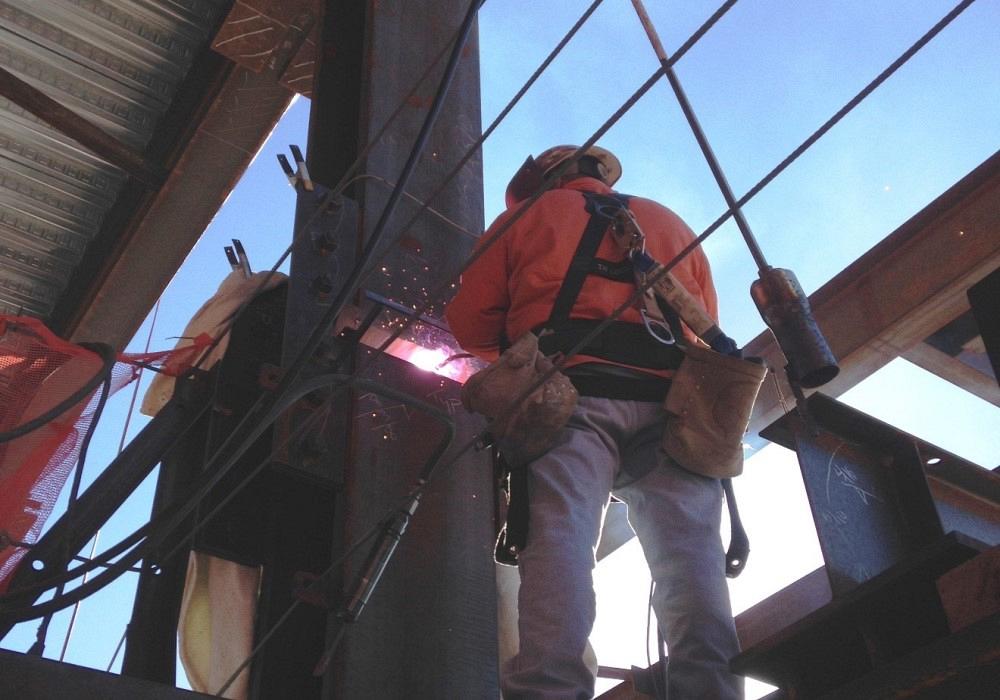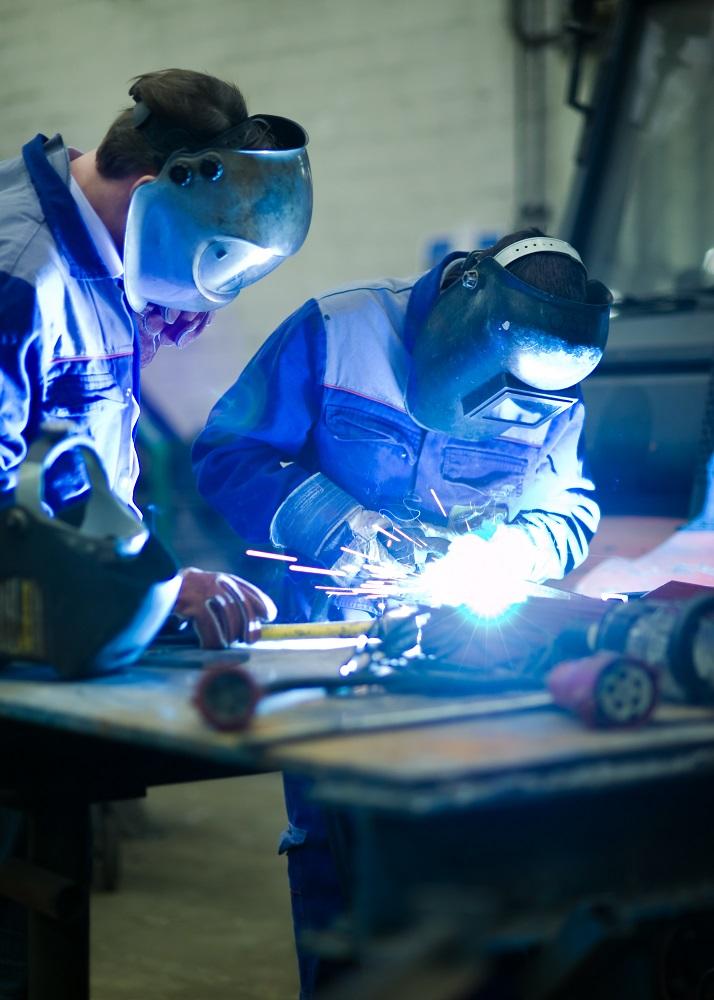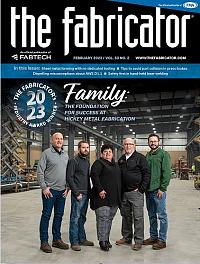Editor-in-Chief
- FMA
- The Fabricator
- FABTECH
- Canadian Metalworking
Categories
- Additive Manufacturing
- Aluminum Welding
- Arc Welding
- Assembly and Joining
- Automation and Robotics
- Bending and Forming
- Consumables
- Cutting and Weld Prep
- Electric Vehicles
- En Español
- Finishing
- Hydroforming
- Laser Cutting
- Laser Welding
- Machining
- Manufacturing Software
- Materials Handling
- Metals/Materials
- Oxyfuel Cutting
- Plasma Cutting
- Power Tools
- Punching and Other Holemaking
- Roll Forming
- Safety
- Sawing
- Shearing
- Shop Management
- Testing and Measuring
- Tube and Pipe Fabrication
- Tube and Pipe Production
- Waterjet Cutting
Industry Directory
Webcasts
Podcasts
FAB 40
Advertise
Subscribe
Account Login
Search
What welders and other metal fabricators should know about AWS D1.1
Most in the metal fabrication industry have heard of the structural welding requirements, but do they truly know what they are?
- By Dan Davis
- February 22, 2023
- Article
- Arc Welding

Most metal fabricators know that the American Welding Society’s D1.1 code for structural welding is important, but some don’t know exactly what it covers.
Can something be both well-known and a mystery at the same time? For many in the metal fabricating industry, that’s where the American Welding Society (AWS) D1.1: 2020 Structural Welding Code—Steel falls.
It’s safe to say that most know that the AWS D1.1 code applies to steel (carbon steel and low-alloy plate and shapes 1/8 to 8 in.) used in the building of structures, but that doesn’t necessarily equate to all heavy fabrication. Also, a job shop can be a certified welding fabricator, under criteria set forth by AWS, but that doesn’t make the company an AWS D1.1-certified shop. As you can see, it can get a bit complicated.
The FABRICATOR spoke with some members of the AWS D1 Committee on Structural Welding to clear the air about the structural welding requirements and the correct terminology that should be used when describing a welder or a shop that demonstrates proficiency in fabricating.
Just What Does AWS D1.1 Cover?
Although some in the metal fabricating industry might think otherwise, AWS D1.1 does not govern all welding in the U.S. While metal fabricators might recognize the independent requirements set up for pressure vessels and pressure piping applications as being separate from those covering other welding applications, some fabricators assume that AWS D1.1 covers all welding processes. But that’s not the case.
“I fear that many look at the word structural and to them it means load bearing,” said Duane Miller, retired manager, engineering services and welding design consultant, The Lincoln Electric Co., Euclid, Ohio. “When we talk structural, we mean something that is anchored to the ground, such as a building or a bridge.”
The American Institute of Steel Construction (AISC) governs how these buildings with structural steel members should be designed and constructed. By law, civil structures are designed and constructed in compliance with a building code, usually the International Building Code. That code requires steel structures be designed and built in compliance with the AISC specification, which in turn requires compliance with AWS D1.1
AWS D1.1 covers material and design, fabrication, inspection, qualification, and reporting and recordkeeping as it pertains to structural steel fabrication and erection. Material and design requirements ensure the structural steel fabrication job gets off to the correct start. Fabrication influences how the work is done, and inspection ensures that the project meets design specifications. Qualification covers the individuals, processes, and welding procedure specifications (WPSs) involved in the fabrication job. Reports and records detail all of these aspects of the job.
If a company wants welding guidance for something that is not structural steel welding, AWS can help because there is likely a welding standard for it, even if those requirements aren’t as well-known as AWS D1.1. If a job shop wants to follow AWS requirements for nonstructural sheet metal welding, it can consult AWS D9.1. If a manufacturer of agricultural equipment is looking for welding wisdom, it can refer to AWS D14.3.
In summary, if a fabricating company, such as a trailer manufacturer, which is obviously concerned about the quality of its product given the weight being placed on it and its use on public highways, says its products are manufactured according to AWS D1.1 standard, it might be making an incorrect reference. (The trailer could be welded to D1.1, but the code wasn’t intended to be used for the welding of trailers.) It should be referring to some other design and welding requirements.
Can a Welder Be Certified to AWS D1.1?
AWS D1.1 requires welders, welding operators, and tack welders be qualified by test. AWS does certify test facilities that then certify welders. Other organizations also test welders. An employer might choose to accept those welders as qualified, but the employer is always responsible to ensure their welders are qualified for the work they perform.

A welder can become AWS-qualified in a specific welding process and procedure by passing an employer-coordinated test. A welder can only become AWS-certified for a process by demonstrating proficiency at an AWS-accredited testing facility.
The performance qualification tests in D1.1 permit welders to use the process they tested in and in the positions they demonstrated ability to perform. Welder qualifications last indefinitely, as long as the welder continues to weld with the process they are qualified for. If a welder does not weld with the process for six months or more, they must requalify.
“Now, there are some major exceptions that we accept, such as the qualifications that are done by a union. But it’s still the employer that is responsible for the qualification of the welder,” said Tom Schlafly, technical representative, AISC, Chicago. “The company can use the union’s tests as evidence of qualification, but the responsibility is still on the employer to make sure that the welder’s qualified and maintains welder continuity.”
For welders looking for credentials that clearly state their knowledge of a welding process, they can apply to be a certified welder through the AWS Certified Welder program. This program tests welders to procedures used for structural steel, petroleum pipelines, sheet metal, and chemical refinery welding industries, for instance. Qualifications that a welder can obtain for processes within the AWS D1.1, Clause 6, Qualification section and that are part of the Certified Welder program include shielded metal arc welding (SMAW), gas metal arc welding (GMAW), flux-cored arc welding (FCAW), and gas tungsten arc welding (GTAW). Additionally, a variety of other combinations of processes and materials are available, including stainless steel (18 ga.-10 ga.); SMAW pipe; GTAW pipe (carbon steel, stainless steel to carbon steel, and stainless steel); and GTAW/SMAW pipe (carbon steel, chrome-postweld heat treatment, and chrome carbon steel).
Welders interested in pursuing this credential have to make an appointment with an AWS-accredited testing facility.Can a Company Be Certified to AWS D1.1?
AWS does certify welds, but the prevalent certification program in structural steel is the AISC Certification program. While AWS evaluates quality criteria related to welding companies, the AISC program also evaluates welding and other functions common in structural steel fabrication.
“In my world as an erector, we read the specifications, and most of them ask for an AISC-certified fabricator or a certified erector,” said Mike Gase, corporate quality director, Midwest Steel, Detroit, and a former third-party inspector for more than 25 years. “I really have yet to see a specification that requires an AWS-certified fabricator.”
Having said that, a company can become an AWS-certified shop through the AWS Certified Welding Fabricator program. The accreditation demonstrates a fabricating company’s commitment to investing in resources, developing the procedures, and training the personnel to produce quality parts, while simultaneously maintaining a quality management system that documents the manufacturing activities.
If a company is already AISC-certified, it is eligible to receive certification as an AWS Certified Welding Fabricator. The AISC certification program criteria fully satisfies the AWS Welding Fabricator Certification program. The same reciprocity does not exist for those AWS-certified companies that might be looking for AISC Certified Fabricator status.
“The AISC programs are structural-oriented and include more specific components related to the construction of civil structures,” Schlafly said.
Is There Anything Special That Stands Out for AWS D1.1 When Compared to Other AWS Requirements?
“One thing that is unusual about D1.1 is a concept called ‘prequalified WPSs,’” Schlafly said. “Most other specs don’t have that concept.”
Without prequalification, the welding procedure has to be qualified. (For further information, consult D1.1, Clause 6.) This obviously can prove very costly and time-consuming.
The prequalified route means that a fabricating company doesn’t have to run physical tests. But for the WPS to be prequalified, all of the variables associated with the specification have to fall within established ranges. (For further information, consult D1.1, Clause 5.) For instance, if the base metal, filler metal, and welding process is being used and the electrical variables during the welding process fall within accepted ranges, the process is considered acceptable. No physical testing is needed.
It also should be noted that welders using prequalified WPSs are still required to be qualified.
For Those Familiar With the D1.1 Standard, Are There Any Misnomers That Still Need to Be Cleared Up?
“What I see that is primarily missed is that companies don’t believe that they must do inspections. The notion is that inspections should be done by a third party, which is not true,” Gase said.
AWS D1.1, Clauses 7 and 8 (as well as AISC 360, Chapter N), require the fabricator or the erector to perform quality control visual inspection of fit-up and welding and ensure that the WPS is being followed by the welder. Any quality assurance performed is to document that the fabricator and erector performed quality control.
Schlafly said that when a third party conducts nondestructive testing, a structural steel fabricator or erector might assume that supplants the need for visual inspection during the fabrication process. The risk is that a critical eye is not taking a close look at the welds.
“That is a real problem,” Gase said, agreeing with his D1.1 committee colleague. “We try to correct that common fallacy when we run into it. We’re working at it, and we’re getting there.”
Bob Shaw, president, Steel Structures Technology Center, Howell, Mich., added that fabricators and erectors often think inspection is only needed when the welds are done, but that is incorrect. An authorized and trained shop or erector employee needs to evaluate what is happening before the weld and during the weld as well. Only then is the welding process under control.
How Often Does AWS D1.1 Change?
AWS used to put out a new edition every two years. That now has evolved into a five-year cycle, with the next update due in 2025.
“The basic fundamentals of D1.1 do not change often and do not change significantly,” Schlafly said. “Now, it can be significant to you if you’re currently working on a project, and all of a sudden a new series of tests are needed because we rewrote a requirement. In general, however, the fundamentals of the code don’t really change.”
Schlafly added that the committee members try their best to avoid such changes because they are trying to keep the fabricators in mind. If anything, many of the changes address a need to clarify something from the previous edition or cover new technology, such as phased array welding inspection.
About the Author

Dan Davis
2135 Point Blvd.
Elgin, IL 60123
815-227-8281
Dan Davis is editor-in-chief of The Fabricator, the industry's most widely circulated metal fabricating magazine, and its sister publications, The Tube & Pipe Journal and The Welder. He has been with the publications since April 2002.
Related Companies
subscribe now

The Fabricator is North America's leading magazine for the metal forming and fabricating industry. The magazine delivers the news, technical articles, and case histories that enable fabricators to do their jobs more efficiently. The Fabricator has served the industry since 1970.
start your free subscription- Stay connected from anywhere

Easily access valuable industry resources now with full access to the digital edition of The Fabricator.

Easily access valuable industry resources now with full access to the digital edition of The Welder.

Easily access valuable industry resources now with full access to the digital edition of The Tube and Pipe Journal.
- Podcasting
- Podcast:
- The Fabricator Podcast
- Published:
- 04/16/2024
- Running Time:
- 63:29
In this episode of The Fabricator Podcast, Caleb Chamberlain, co-founder and CEO of OSH Cut, discusses his company’s...
- Trending Articles
Capturing, recording equipment inspection data for FMEA

Tips for creating sheet metal tubes with perforations

Are two heads better than one in fiber laser cutting?

Supporting the metal fabricating industry through FMA

Omco Solar opens second Alabama manufacturing facility

- Industry Events
16th Annual Safety Conference
- April 30 - May 1, 2024
- Elgin,
Pipe and Tube Conference
- May 21 - 22, 2024
- Omaha, NE
World-Class Roll Forming Workshop
- June 5 - 6, 2024
- Louisville, KY
Advanced Laser Application Workshop
- June 25 - 27, 2024
- Novi, MI


























